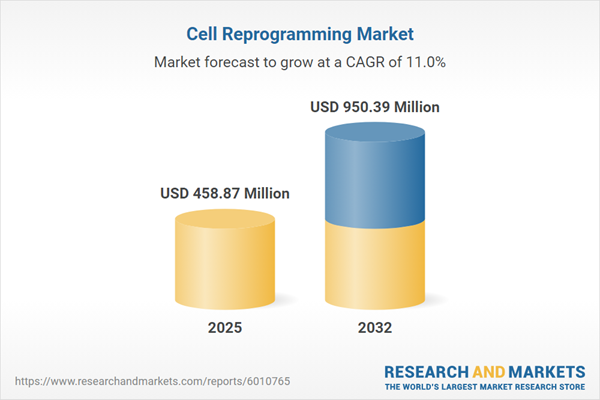Speak directly to the analyst to clarify any post sales queries you may have.
The cell reprogramming market is transitioning rapidly, powered by technological innovations and evolving business models that are redefining research approaches and therapeutic solutions for regenerative medicine. This report offers actionable intelligence tailored for senior industry leaders navigating a dynamic ecosystem.
Market Snapshot: Growth Outlook in the Cell Reprogramming Market
The Cell Reprogramming Market advanced from USD 413.88 million in 2024 to USD 458.87 million in 2025 and is forecasted to expand at a compound annual growth rate (CAGR) of 10.95%, reaching USD 950.39 million by 2032. Market momentum is being shaped by the integration of genome editing, automation, and digital optimization, underpinning both patient-specific research and clinical development.
Scope & Segmentation: Strategic Coverage Across Technologies, Applications, and Regions
- Technology Platforms: Direct reprogramming, Induced pluripotent stem cell (iPSC) protocols
- Cell Types: Cardiomyocytes, Neurons, Pancreatic beta cells
- Application Domains: Cell therapy, Disease modeling, Drug discovery
- Reprogramming Methods: Small molecule modulators (DNA methyltransferase inhibitors, Histone deacetylase inhibitors), Transduction (viral and non-viral vectors), Transfection (electroporation, lipid-based delivery)
- End Users: Academic institutions, Biotechnology & pharmaceutical companies, Contract research organizations (CROs)
- Regional Coverage: Americas (North America and Latin America, including the United States, Canada, Brazil, and others); Europe, Middle East & Africa (including the United Kingdom, Germany, United Arab Emirates, South Africa, and more); Asia-Pacific (China, India, Japan, Australia, South Korea, and additional leading countries)
- Company Focus: Analysis of leaders such as Thermo Fisher Scientific Inc., Merck KGaA, Lonza Group AG, Danaher Corporation, STEMCELL Technologies Inc., Takara Bio Inc., FUJIFILM Cellular Dynamics Inc., Miltenyi Biotec GmbH, Bio-Techne Corporation, and ReproCELL, Inc.
Key Takeaways for Strategic Decision-Making
- Direct reprogramming is being prioritized for rapid, streamlined generation of functional cells, supporting both preclinical studies and translational programs.
- Integration of artificial intelligence and automation has improved the reproducibility and predictive modeling of reprogramming processes, enabling faster R&D cycles.
- Cardiomyocyte, neuronal, and beta cell models are at the forefront of efforts targeting regenerative therapies and disease modeling across cardiology, neurology, and endocrinology.
- Innovative approaches using small molecule modulators minimize genetic disruption, optimizing safety and applicability for future clinical products.
- Cross-sector partnerships, involving academic, biotech, and pharmaceutical stakeholders, are driving standardization and seamless pipeline integration.
- Contract research organizations are enhancing service portfolios, bridging discovery and validation phases for clients pursuing scalable and reproducible solutions.
Tariff Impact on Cell Reprogramming Supply Chains
The implementation of targeted tariffs in the United States beginning in 2025 has raised procurement costs for imported reagents, consumables, and equipment, impacting sourcing and operational strategies. Stakeholders have responded with diversified supply chains, regional manufacturing initiatives, and stockpiling to ensure continuity. Collaborative agreements between organizations are also mitigating cost pressures and bottlenecks, while ongoing engagement with regulators supports adaptation to shifting trade environments.
Cell Reprogramming Market: Approach & Methodology
This report applies a robust, mixed-methods approach, combining a systematic literature review with structured interviews and Delphi panels involving scientists, engineers, and regulators. Insights are triangulated using patent records, supplier data, and trial registries. All findings are peer reviewed by industry experts to validate accuracy and relevance for market evaluation.
Why This Report Matters
- Enables senior leaders to identify evolving technology trends and strategically allocate R&D, partnership, and capital resources.
- Highlights regional investment patterns, regulatory environments, and competitive positioning critical for global expansion and local market entry.
- Equips executives to mitigate risks posed by shifting tariffs and supply chain disruptions while capitalizing on emerging partnerships and technology alliances.
Conclusion
This analysis provides decision-makers with a rigorous, actionable perspective on the evolving cell reprogramming market. Apply these insights to steer innovation, investment, and partnership priorities to capture new opportunities in regenerative science and therapeutic development.
Additional Product Information:
- Purchase of this report includes 1 year online access with quarterly updates.
- This report can be updated on request. Please contact our Customer Experience team using the Ask a Question widget on our website.
Table of Contents
3. Executive Summary
4. Market Overview
7. Cumulative Impact of Artificial Intelligence 2025
List of Figures
Samples

LOADING...
Companies Mentioned
The key companies profiled in this Cell Reprogramming market report include:- Thermo Fisher Scientific Inc.
- Merck KGaA
- Lonza Group AG
- Danaher Corporation
- STEMCELL Technologies Inc.
- Takara Bio Inc.
- FUJIFILM Cellular Dynamics Inc.
- Miltenyi Biotec GmbH
- Bio-Techne Corporation
- ReproCELL, Inc.
Table Information
| Report Attribute | Details |
|---|---|
| No. of Pages | 197 |
| Published | October 2025 |
| Forecast Period | 2025 - 2032 |
| Estimated Market Value ( USD | $ 458.87 Million |
| Forecasted Market Value ( USD | $ 950.39 Million |
| Compound Annual Growth Rate | 10.9% |
| Regions Covered | Global |
| No. of Companies Mentioned | 11 |









